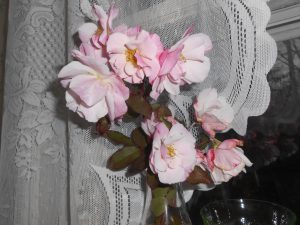Getting your Roses Ready for Winter
Views: 5658

Here we are in late Autumn; I can’t quite believe it! As our gardening responsibilities wane, family and friends take center stage in our lives. Thanksgiving has passed and the air is finally getting colder. I got all my roses cut back on the last warm weekend we had, so let the winter come! I’m actually hoping for some snow this winter. Last winter we were pretty much passed by which didn’t help the severe drought we are experiencing here in northcentral Connecticut.
People ask me why I cut my roses back in the Fall. It is not imperative that this be done. However, in our area we usually get some big ice and snow events. As our roses grow tall during the season, they finish up top with more twiglike canes that become entwined with each other. If we get one of our famous Nor’Easters with all this tall growth, chances are that those canes will get crushed and shattered by the weight of the ice and snow. With the top growth removed, the ice and snow can fall down between the canes and onto the ground where it helps to insulate the plants.
Persnickety Pruning
I always call my fall cut-back ‘Gross Pruning.’ Not because it is disgusting or anything like that. This pruning is quick and I know I’ll do my ‘Fine Pruning’ in the spring. My hybrid teas and grandifloras get cut back to about knee high, as do my floribundas. Minis and minifloras get cut back to around 10″ or so. Climbing roses are tied to their supports and the tips trimmed so they don’t get whipped about by the winter winds. Shrubs get cut back by at least a third to prevent crushing by frozen precipitation, and my old garden roses are on their own because they need two year wood to bloom on and generally come through the winter just fine.
Winterizing
I begin my winter protection program when I plant my roses by burying the bud union, or crown, of the plant about 4″ below soil level. All good things come from this part of the plant. With the crown buried, it is protected from day one. This also protects about 4″ of green cane. This carries multitudinous buds that can become new canes bearing many blooms for us to enjoy. The other benefit to burying the bud union is that it puts down its own root system. This makes the rose doubly strong. (This method is for our northern climes only. In the sandy southern states, nematodes will attack a buried bud union. They plant their roses with the bud union above ground.)
Because my roses are planted deeply, when I’m finished cutting all I do is to fluff up the mulch a little and then I’m done! If the winter is severe and the canes die down to the ground, I can cut them all the way down. The rose bushes have great established root systems. They push up beautiful new growth from those protected buds on the buried canes. Don’t forget to feed your plants.
Mulching
If your bud unions are at or above ground level, you will have to mound them up with something. This should be done after there is a little frost in the soil. We don’t want voles taking up residence in your winter protection! Some rosarians bring in soil to mound up the plants. I would use shredded pine bark mulch which mounds nicely and won’t wash off in heavy rainstorms. It will freeze to the canes and protect them all winter.
We winter protect to get our roses cold and keep them cold during the winter so they’re not tempted to sprout in a January thaw. Whatever you choose to winterize your roses, all you have to do is dump it directly on the plants where it will mound up. The advantage to using mulch is that you can just spread it around in the spring. Soil will probably need to be taken removed from the garden at the end of the winter.
In a salute to this growing season I am pleased to let you know that I had roses in my gardens this year from the middle of May until the end of November. The first rose to bloom this past spring was ‘Clair Matin’. This gorgeous climber we grow as a fountainous shrub here in Connecticut. Know what? ‘Clair Matin’ was also the last rose to bloom in my garden! She is a lovely pink rose that is reminiscent of apple blossoms and her picture is above. She was the Alpha and the Omega in my garden this season. I have kept this cutting and am starting a new bush to give away in the spring…which will arrive before we know it!
Meet Marci Martin
Marci Martin has loved roses for as long as she can remember. From the time she was a little girl, she was fascinated with how…
Marci's Recent Posts

Roses and Friends at Race Point Lighthouse








